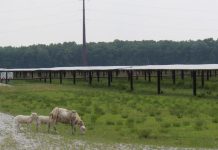“Over the past 50 years we’ve made such incredible progress in working for a cleaner, healthier environment for the American people,” said EPA Assistant Administrator for International and Tribal Affairs Chad McIntosh. “I am particularly proud of the productive and successful relationship EPA has with federally-recognized tribes – we are building on our mutual respect and trust to build capacity and protect human health and the environment in Indian Country.â€
“For the past 50 years, EPA has relied on the hard work of our dedicated expert staff and tribal partners to address environmental challenges and in strengthening environmental and public health protection in Indian Country,â€Â said EPA Director of the American Indian Environmental Office Scott Mason. “Looking ahead, we’re committed as ever to working collaboratively with our tribal partners over the next 50 years to achieve our shared goals.
The Agency’s new accomplishments timeline highlights key milestones that have shaped EPA’s successful partnership with tribes leading to environmental protection progress over the last 50 years.
Notable accomplishments include:
1980: EPA became the first federal agency with an official Indian Policy, the EPA Policy for Program Implementation on Indian Lands, which expressed EPA’s commitment to working with tribes and EPA’s belief that tribes play a key role in implementing pollution control programs affecting their reservations.
1986:Â Congress began amending major environmental statutes to create new roles for tribes in administering regulatory programs starting with the Safe Drinking Water Act and the Comprehensive Environmental Response, Compensation and Liability Act.
1992: The Indian Environmental General Assistance Program Act (GAP) created a new EPA tribal grant program to help tribes build environmental program capacity. Tribes use GAP grants for planning, developing and establishing environmental protection programs in Indian Country, and implementing solid and hazardous waste programs on tribal lands. GAP has since become EPA’s largest tribal grant program that includes both tribes and intertribal consortia, with a recent average appropriation of over $60 million per year.
1995: Region 5 Administrator, Valdas V. Adamkus, signed the first-ever Tribal Environmental Agreements (TEA) between EPA and the elected leaders of 11 tribes in Minnesota. Each TEA describes EPA’s regulatory program implementation roles and responsibilities for each tribe and the tribe’s environmental priorities and baseline program needs. Today, EPA continues joint environmental planning with each tribe through EPA-Tribal Environmental Agreements (ETEPs) and has individually negotiated ETEPs with almost 500 tribes across the country.
2000:Â Navajo Nation became the first tribe authorized to administer the Public Water System Supervision (PWSS) Program under the Safe Drinking Water Act. To date, the Navajo Nation is the only tribe with primacy to implement a tribal PWSS program and have enforcement authority under the Safe Drinking Water Act over drinking water systems.
2007:Â The First Tribal Implementation Plan (TIP) is approved by EPA and put into effect by the St. Regis Mohawk Tribe. A TIP is a set of regulatory programs a tribe can develop and adopt to help attain and/or maintain national air quality standards. The St. Regis Mohawk Tribe protects air quality on the reservation through the approved TIP.
2012:Â Quapaw Nation was the first tribe to lead cleanup of a federal Superfund National Priorities List site, Tar Creek, Ottawa County, Oklahoma. This site is one of the largest and oldest Superfund sites in the country. With funding assistance of over $9 million, the Oklahoma Department of Environmental Quality and the Quapaw Nation of Oklahoma removed approximately 568,000 tons and 1 million tons, respectively, of toxic chat from the site providing a healthier environment for the citizens of Northeastern Oklahoma.




